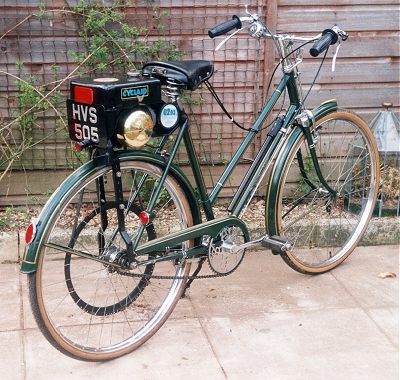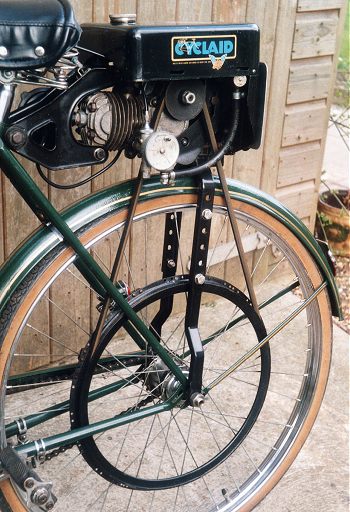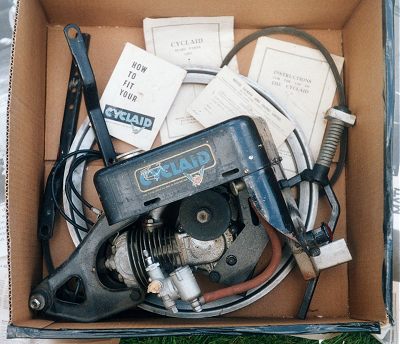 Go
to the Archive index
Go
to the Archive indexAs the last of the undergrowth was dragged clear, Anne declared "It's an old shed!" Julian emerged from the dusty gloom; "We can use this!" He had found a small engine. A further search turned up an old bedstead, pieces of rusty Dexion brackets, a broken ladder and an ancient spirit tin. After a couple of hours feverish sawing, hammering, drilling and screwing, the machine was finished. "What is it?" said Georgina. "Don't girls know anything?" said Dick, perplexed, "It's a Cycle-Aid" as the contraption rattled into life and he whizzed off down the lane leaving a billowing trail of blue smoke in his wake. Despite its makeshift appearance, the Cyclaid went surprisingly well, and the rest were left pedalling furiously behind him on their bicycles, with Timothy running along in pursuit, barking excitedly.

British Salmson Aero Engines Ltd of Raynes Park was established in 1930 to build air-cooled radial engines of French Salmson design. This however failed to generate sufficient orders, and by 1934, the company was angling round for additional business. Salvation materialised in the form of various subcontract engineering works, and construction of 1½ - 2½ litre coach-built sports cars with bodywork by Ranalagh or Newns, of which some 350 were built, up to 1939. While the factory was bought by Napier Aero in 1947, the former directors went on to register the new British Salmson Cyclaid Company from an office at 76 Victoria Street, London SW1. The 31cc × 0.75bhp, all alloy, two-stroke Cyclaid attachment kit became offered from 1950, though the motor was actually a licence-built derivation of Rex design, assembled at Larkhall industrial site near Glasgow. The motor featured the characteristic Rex extended crankcase cavity system, to house the primary reduction gearing, and lubricate these parts and all bearings by means of the induction gases.

Horizontally mounted over the rear wheel, the motor unit proved quite consistent, while the belt drive down on the left-hand side effectively smoothed out the unpleasant transmission snatch that affected many competitor's direct roller-drive designs. Sparks came from a Wipac Bantamag set, with a lovely pressed brass cover that would polish up beautifully, once you'd got the awful silver paint off it.
Tyre consumption was not at all the issue that afflicted roller driven cycles, while the aft mounted engine offered better stability than installations over the front wheel. The Cyclaid displayed all the features of a more practically thought out machine, and is justly credited with a reputation as one of the 'nicest' clip-on units.
Now if you're going to do a test on such a machine, you really want to do it on a good one - and this fine example, mounted on a mellowing earlier restoration of a 1952 BSA Streamlight cycle, surely falls among the very best available. The motor is dead original with pretty minimal operational time (some may even call it barely run-in), half a century old and in perfect prime, amazing! And if you think the bike's impressive in itself, you should see the incredible spares! Lain down forever like the finest wine, and probably destined never to be run due to its speculative value - a brand new Cyclaid kit, exactly as the customer would have bought it fifty years ago!

Now, anyone's impression of a cyclemotor is unlikely to be influenced by any factor greater than your own point of reference. If you step from an autocycle or moped, most clip-ons will seem very basic and underpowered - but starting from a cyclist's viewpoint, the cyclemotor is a truly wondrous device. If you're a 'dyed in the wool' motor cyclist and you want to try to appreciate a cyclemotor, ride a bicycle first,then tell yourself that the bicycle is your only transport - but you can attach an engine to it! With such cheap and basic power units you can largely forget about such luxuries as clutch and gears, cyclemotors are invariably direct drive, single-gear arrangements. And don't expect such small, old-world motors to propel you along much under their own steam; they are generally an auxiliary device and you should still expect to offer them light pedal assistance, but they will greatly increase the practical range of your bicycle. If you feel your cyclemotor is underpowered and inadequate over, say, a ten mile ride, then remove it, and do the same trip on pedal power alone - you'll soon appreciate what the attachment was contributing!
The Cyclaid unit does not have a ready drive release, so non-running movement of the cycle is negotiated with the decompressor on. Back out of the shed, blup, blup. Around the house, blup, blup, blup, blup. Down the drive, blup, blup, blup - it gets a bit irritating not having a neutral! Fuel turns on with a pull tap hidden under the back of the tank, full strangle on the carb shutter, then gently pedal away and release the decompressor. The 5.6:1 compression ratio offers little resistance, and to commence firing most easily, a light take-up on the throttle proves best. Continue pedalling assistance in this manner for a few moments to warm the motor, then reach behind you to open up the strangler (that's if you can find it behind your back, under the fuel tank, on an unfamiliar machine). Alternatively, stop again, dismount, open out the choke shutter, and restart again. Even with the strangler open and the engine warm, the Cyclaid only seems to want to initiate firing with the same light take-up of the throttle, handfuls of twistgrip simply obtain no result in the starting procedure. A few slow turns in the road to get the feel of the balance and manners, at which the little 31cc motor proves remarkably tractable! Fixed drive, no clutch, yet it still runs dead smooth performing tight cycle turns at an absolute trickle! You simply could not ride so controllably on any clutch/geared machine or even an automatic moped.
Ok, now the Cyclaid has won first place in the slow riding competition, let's open her up along the road - well, not so much a case of acceleration, as pedal assisting it to build up momentum. While it would prove capable of such a feat on its own merit, there is little purpose in labouring the point. The throttle isn't so much a mechanism to regulate how hard the engine's pulling, as a device to delay the rate at which you slow down to whatever pace the Cyclaid decides it wants to run under the prevailing conditions. The motor soon asks for a bit of help on inclines or into a head wind, though the true input required from the rider becomes little more than occasional 'no load' pedalling - the motor is really doing most of the work. Presumably a normal condition of the breed, engine performance on this example actually falls off toward full throttle, accompanied by an audio indication as the crisp warbling from the exhaust starts to flatten out, and shortly breaks into intermittent bouts of four-stroking. I'm afraid it's that old Rex problem of too small an exhaust port again, so ease the throttle down a bit, the note sharpens up, and the engine starts pulling better once more. Improving spent gas clearance through a larger exhaust port, and raising the compression ratio would probably resolve the flat throttle and four-stroking issues, plus find a couple more mph, but it's questionable how much one would expect the cycle rod-braking systems to maintain an effective contribution. Salmson claimed 18-20mph, which pretty much represents a steady cycling pace without the pedalling effort. There is no lighting coil included with the Bantamag ignition set, so illumination remains the preserve of cycle systems, in this case a front tyre driven friction dynamo.
Probably the mounted Cyclaid's greatest weakness was its vulnerability to falling over when parked, as the resultant high centre of gravity from a 15lb motor perched on top of a bicycle rack would always be courting disaster from gusts of wind or pedestrian contact. Conventional cycle prop stands or leaning against a wall, were both pretty unstable, and the best available precaution would probably be a Suresta centre stand.
The Salmson kit came in right at the fore of the cyclemotor boom, and its cheap DIY appeal with 300mpg economy claims managed enough sales to keep the unit on the market for 5 years. Due to its amiable reputation, the Cyclaid now falls amongst the most sought after and prized of attachment units for those who enjoy the gentle pace of cycling, but without the effort of pedalling.
British Salmson did continue beyond the Cyclaid at the Larkhall works, finding new direction in the manufacture of printing presses, while the old Raynes Park factory subsequently became turned over to jam making!
Anne has written two books on ornithology and is currently hiking the Andes, Julian is an accountant, married with three children and lives in Basingstoke. Georgina had a sex change in 1994 and now calls herself George. Dick has had a string of businesses, and successive bankruptcies. He is now banned from holding directorship. Timothy was run-over chasing a cyclemotor in 1957.
Coming next, a production bike unlisted in any reference book and never covered in any item, by anyone, ever! This major research project has been running for two years to collate enough material to finally get the article to press. Buzzing takes you on a trip to the stars - to boldly go where no mag has gone before!
First published, October 2002